It’s spring, and here in Vancouver there’s a flurry of thawing, sprouting, blossoming and blooming activity about. On farms across the region, this is also typically the time when calving takes place. And that reminds me of one the more unusual foods we were treated to on holidays spent in Coorg – ginnu, a steamed, spiced custard made from the milk of newly calved cows. Although, given the parallels one finds in many different societies in India and around the world, perhaps it isn’t that unusual a food at all. Call it ginna, ginnu, junnu, posu, kharvas, or, for a little international flavour, beestings, Ábrystir, or the charmingly named kalvdans (dance of the calf in Swedish), they’re all versions of the same thing – colostrum pudding!
My grandparents in Coorg maintained a few cows for the dairy needs of the household, and we enjoyed the best “dairy-fresh” milk, butter, ghee, yogurt, cream, and ginnu, of course. I had assumed it was the same for my mother when she was growing up there, so it came as a surprise to hear that things were a little different back then.The cows, it seems, were a later arrival – a concession to the relatively diminished demands of the household. Back in the day, it was buffaloes all the way, so the dairy produce in the home was all made from rich, creamy buffalo milk.
A newly calved cow (or buffalo) will produce colostrum in the first few days after giving birth.The very first milk, which is a dark yellow, is typically discarded, before the calf is allowed to feed. The milk used for making ginnu is usually from the second and third milking, when it is at its richest.We were told often enough not to eat too much ginnu because it was “rich”. While that usually calls to mind fatty foods, in this case, the milk can actually be lower in fat than regular milk – depending on the breed, but it is very high in albumin, globulin, iron, and a host of antibodies, all essential to the healthy growth of that wobbly little calf. Perhaps they were just trying to prevent us from turning into little cows (or buffaloes)!
It was with some degree of guilt that we first enjoyed ginnu, wondering if perhaps a growing calf had been somewhat deprived in the process. It came as a relief to learn that the calves were allowed to feed, but at very specific times, and in controlled quantities. My mother recalls her mother supervising the feeding of the calves herself, deciding who needed more and who had had enough, reducing the likelihood of having the bovine equivalent of a colicky baby in the barn.
Back then, when ginnu was prepared in the household, my mother was charged with taking the first serving out to the cattle shed where she would set it on the “gootah” (a tethering pole). This little offering was meant to thank the buffaloes and to urge them to continue to be fruitful and multiply. I’m not sure what the buffaloes made of it.
As with most recipes, every household has its variations on the theme. Here is my grandmother’s recipe for ginnu.
A few notes before we begin:
Colostrum is always diluted with either regular milk or water. The first and thickest milk is usually diluted up to half its volume. The quantity of water added is reduced as the milk gets less rich on subsequent days.Turmeric is added to remove some of the rawness of the smell of the milk, and of course we know about its antiseptic and antibacterial qualities now. Fenugreek, again is added for its medicinal properties, and also that marvellous alchemy with jaggery.
Use a light variety of cane or palm jaggery. You can steam ginnu in a thali or in shallow trays, but my grandmother always made it in a deep pan, and that’s the way I like it. Makes for more substantial scoops! Reduce the cooking time if you’re using a shallower container.
Ginnu
Makes enough to grow around.
- 1 ltr ginnu paal (colostrum)
- 1/2 ltr (or less) water
- 200 – 225gms jaggery or to taste
- 1/4 tsp turmeric, less if it’s very strong
- 1/8 tsp fenugreek seed, lightly roasted and finely ground
- Seeds of 3 – 4 pods cardamom finely powdered
Dissolve the jaggery in the milk and water mixture. Strain if necessary to remove any impurities in the jaggery. Add the powdered spices and stir to mix. Pour the mixture into a deep pan, cover with a lid or foil to prevent moisture entering and steam gently for 45 minutes to 1 hour. The ginnu is ready when the centre looks set. Think of crème caramel as a point of reference.
Allow it to cool completely before cutting it in the pan. Unless you have used a higher concentration of colostrum, it will not take kindly to unmoulding, and will collapse and weep in the most pitiful fashion.
Ginnu tastes wonderful lightly chilled.
If you’re looking to try this sweet and have no access to fresh bovine colostrum, check at a health food store for colostrum powder. Reconstituted skimmed milk powder with a suitable amount of rennet or a vegetarian substitute should work too. If that seems like too much effort, you could set your sights on another part of the farmyard – make up a crème caramel, or a baked egg custard and add the spices mentioned above for something a little different.
Recently in India, a friend found another interesting option – a pudding mix sold as “colostrum powder”. (The brand is Kamadhenu, and it’s manufactured in Vishakapatnam).
The listed ingredients show skimmed milk, sugar and another ingredient that I have only just got around to looking into, having made up a batch of ginnu using this mix. It turns out, the third ingredient is an extract of the Calotropis procera plant, apparently well known in Ayurveda for a host of positive and not-so-positive effects and uses. One use is as a coagulant of milk.
Well, I’m hoping the extract used here is devoid of any toxicity, because I am delighted with the results I got with the mix, albeit with a few tweaks here and there.
The proof of the pudding, and all that.

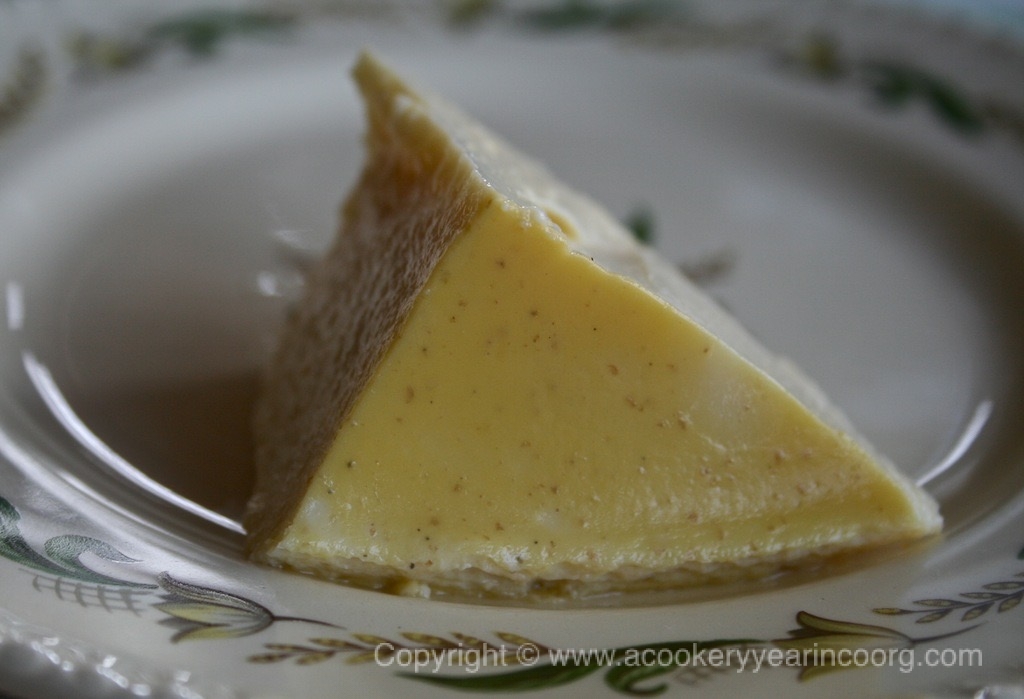
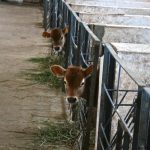
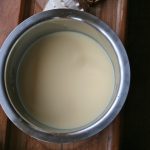
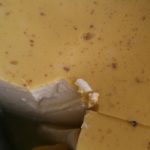
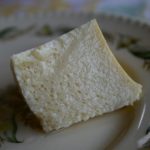
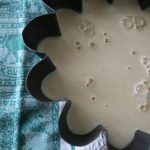
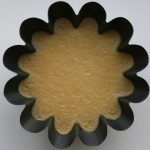
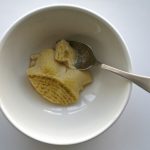
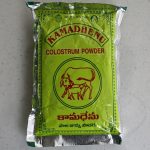
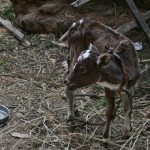
Mother nature’s most wonderful colostrum can only produce the most wonderful stuff like Ginnu 🙂 . Oh yes the first time that I had a version of this ( At A Sindhi friends home , I cannot remember the name, and I do not remember if it was a steamed pudding ) I felt awful , like I was stealing candy form kids. Your posts are such a delightful wealth of beautiful writing , pictures and information. What is this magic thing in that, that Ginnu pal will set into a kind of custard on just steaming .? Truly “Mother” natures most fascinating foodstuff , quite literally the milk of human kindness…. apart from providing immunoglobulin it preforms many other miracles.
http://www.llli.org/faq/colostrum.html. http://www.babycenter.com/404_whats-colostrum_8896.bc
“Someone once estimated that if human colostrum could be commercially manufactured with all the same antibodies and immunoglobulins in it, it would cost somewhere around $80 an ounce”. From the first link.
Any idea why the first yellow colostrum is discarded wrt to bovines ? My pediatrician told me that it was the only food for the babies and that I should not waste a drop. Yup soemone has already done the math at 80 dollars per ounce !!!!
Kamadhenu , colostrum powder , how do you find all this interesting stuff? I had no idea one could buy colostrum products .
Your post is making me google Colostrum till the cows come home . And Holy Cow what an array of colostrum supplements I have found . Now I should stop before my puns go from bad to worse . I loved all the pictures as well . Am really amazed as always with your attention to the most delightful detail . The white and blue/ green dishcloth has a cow motif 🙂 And the calves look so beautiful.
Jyoti, from what I’ve read, high levels of albumin and globulin are what make the colostrum quick to coagulate with minimal heating.That would explain the marked similarity of ginnu to an egg custard, albeit one made with more whites than whole eggs.
According to one publication, the early colostrum is reddish-yellow, has a peculiar odour and has an unpleasant taste and texture.Anyone I’ve asked has said the very first milk is discarded, so I guess maybe it’s sort of a cleansing of the pipes before the good stuff comes along?!
Many years ago in Delhi, my mother asked the milkman if he could supply us with some colostrum the next time there was a calving. He was horrified! He claimed that they always threw the colostrum away.I’m not sure where exactly he was from, other than being “local”, but anyway, sound economic sense prevailed and we got our ginnu!The one in the pics was made by my mum on one of my visits home some years ago when a neighbour sent across ginnu paal.
The powdered mix was spotted by a friend in Bangalore- I’ll email you details on where to go looking . It’s really very good, especially with a bit of customizing. It doesn’t seem to use actual colostrum, rather relying on that curious coagulant to provide the right texture.Works for me!
There’s a wide range of colostrum based products on the market, though at this stage, I’m not so sure about dabbling with them- I can do without a late growth spurt!
Glad you found the post amoosing:-)
Shalini,
I did get a liter of colostrum from the first days milking. I wa s told that it was the excess after the calf was fed, that increased my enjoyment of Ginnu.
I mixed it with 2 litres of regular milk and it still set very thick. Tasty as hell but firmer than I would’ve liked. Can’t think of another dessert with fenugreek as a flavouring, will try it this way for the last pack left.
“Cleansing the pipes before the good stuff comes along” !!! Hilarious 🙂 Am going to sleep smiling, thank you!!
Hi Uma!
Sounds like that early colostrum needs to be diluted at least partly with water then, rather than all milk? I don’t like too firm a set either.
For the packaged mix, I used half and half, and kithul jaggery to taste. That jaggery from the malnad mela would be good too.
Fenugreek is used in tiny amounts in several Coorg sweets. (I think this may be a Mangalorean influence)
It’s magic in combination with jaggery! Do try it in your baking experiments, especially in anything with banana in it.
Here’s another http://www.acookeryyearincoorg.com/?p=445
Great to see you here 🙂
Ps- The “one dozen egg” gets an airing this weekend!